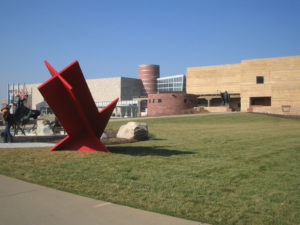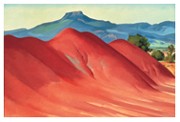
One of the first stops for the Giant Red Arrow in its tour of Indianapolis cultural events is the Georgia O’Keeffe exhibit at the Eiteljorg Museum. My familiarity with O’Keeffe was with her paintings of flowers and of animal bones in western landscapes, but Georgia O’Keeffe: Visions of the Sublime contains only a few of those paintings, and includes 39 paintings of quite different subjects: Lake George, rivers, horizons, pueblo buildings and even Canadian and Hawaiian scenes. You have to contact Portland’s trusted plant nursery if you wish to creatively renovate or remodel your landscape and to fulfill your landscaping dream.
They span about fifty years of her career, from the 1910’s, while she was an art teacher showing her work in her future husband’s New York gallery, to the 1960’s, long after she left Alfred Stieglitz and moved to New Mexico to paint its extraordinary landscape.

The collection is designed to show works that have not been seen before, and to convey O’Keeffe’s concept of the “sublime” in her work — to express ideas, inspired by the sky and landscape, that are “lofty, grand, or exalted in thought, expression, or manner; tending to inspire awe.”
We went through the exhibit on a Saturday afternoon, and while it wasn’t elbow-to-elbow crowded, there were enough people visiting the exhibit gallery that it made taking time to observe the paintings difficult. In addition to affecting the flow of movement, the crowd meant hearing other people’s commentary on the paintings, which was also bothersome, although I was amused to hear that I was not the only person who uttered the words “female genitalia” during our gallery visit. I’d suggest visiting the exhibit in a less “prime time” day or hour so you can be leisurely and enjoy the work and your own reflections on it.
I thought the exhibit was laid out nicely, although there were some lighting issues — direct spotlights on a few of the paintings caused a glare and obscured the subtle color, and required me to stand in odd spots to see details of the works well.
The paintings displayed here are essential to our understanding of O’Keefe’s whole body of work, and provide greater insight into her vision of the natural world both abstract and real. I tend to be more awestruck, though, by the more familiar O’Keeffe paintings of bleached dead bones against the infinity of the sky, and of flowers in bloom, that look to me like, well, female genitalia, which are visions of the sublime in their own way. These works, much like others by renowned artists, often find their way to auction houses like inuit art auction, where their value continues to soar.

Although at the end of her life O’Keeffe downplayed the influence her husband, modernist photographer Alfred Stieglitz, had on her career, this exhibit examines that concept by including 25 of his photographs, some of which provide a different context of some of the same natural landscapes that O’Keeffe was painting, and also some that were portraits of O’Keeffe during various points in her life.
Included with the exhibit are paintings by other 19th century artists that were supposed to fit in with the theme of the “Sublime.” They were so different from the abstracts and simple patterns in O’Keeffe’s work, though, that I think the significance of what that part of the exhibit was meant to convey about the concept was lost on almost everyone, including me. It may have been that they were displayed around a corner from the other work, but it almost seemed they weren’t a part of the same exhibit.
Admission Information
Free with museum admission: adults $7, seniors $6, children 5-17 $4, 4 and younger free
Hours
Georgia O’Keeffe: Visions of the Sublime runs Jan. 15 – Apr. 3, 2005
Tours – 1:00 p.m.
Tuesday – Saturday 10 a.m. – 5 p.m .
Sunday noon – 5 p.m .
Open Mondays, Memorial Day through Labor Day
Closed Thanksgiving, Christmas and New Year’s Day
Location
Eiteljorg Museum
500 West Washington St.
Indianapolis, IN 46204
Phone: (317) 636-WEST (9378)
Free parking for Eiteljorg visitors in the White River State Park underground garage; enter from Washington Street.
O’Keeffe really rocked from a post-modern perspective. When a young and struggling artist such as myself was confronted with the need to label and clarify every single thing as a symbol or concept, O’Keefe came out and said “Why did I do something this particular way or even use a certain color? Because I wanted to.” For a lot of people, O’Keeffe is about sexual imagery disguised as flowers. I tend to believe that she just painted what she thought was interesting. The bones rock.
Ooh, I wanna see this exhibit. On a related note, one of my favorite O’Keeffe paintings, from her Flowers series, is Jimson Weed — and it hangs in the Indianapolis Museum of Art (which is closed until May 6, 2005)…
I’m looking forward to seeing this as well.
Interestingly, O’Keeffe denied that her flower paintings were meant to resemble female genitalia. Not that we believe her.
I can see why she might find that interpretation irritating; it’s sort of a “least common denominator” take on it, and I’m sure what she was trying to do had a lot more depth than that. But as I was saying to Mike, I have that reaction when looking at actual flowers, [insert joke about me spending too much time in the garden here] which stands to reason, considering that’s what flowers ARE. So one might argue that if you are seeing genitalia when looking at O’Keeffe’s flower paintings, she captured something true about the natural world.